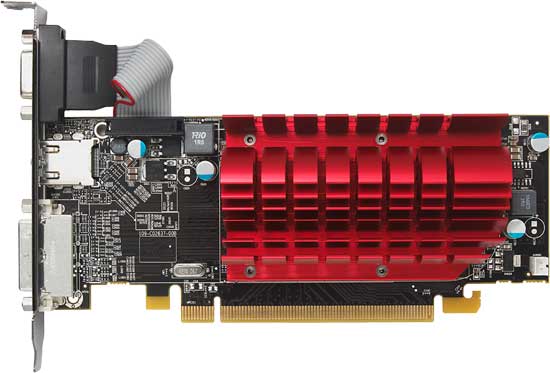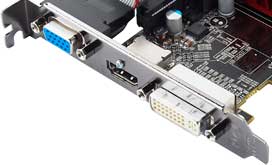AMD’s Radeon HD 5450: The Next Step In HTPC Video Cards
by Ryan Smith on February 4, 2010 12:00 AM EST- Posted in
- GPUs
Meet the 5450
As luck would have it, we ran in to a bit of a snafu yesterday morning when wrapping up our test of the 5450. As we stated in our intro, the DDR3 Radeon 5450 is supposed to be clocked at 650MHz core and 800MHz memory, but that’s not what we got. Internally AMD has been sampling a 650MHz/900MHz card for one of the OEMs they work with, and a few of those samples made it out with the 650MHz/800MHz review samples for the press. As one of the (un)lucky winners, we received a 650MHz/900MHz sample, meaning our card isn’t quite a reference card. Thankfully we have more than one 5450 and we were able to benchmark a stock-clocked Sapphire card, but keep in mind a proper built-to-reference card is going to be equipped with slightly different RAM than our sample is. Besides the RAM chips, everything else about our sample is the same as a reference card.

With that out of the way, the 5450 is intended to be a replacement for both the Radeon 4350 and the Radeon 4550. The former was AMD’s previous low-profile card, while the latter was the DDR3 equipped version. Thus we have something similar in size and power usage as the 4350, but packing the “complete” abilities of the chip like 4550.
The 5450 AMD is sampling is the 512MB DDR3 version, for which the reference clocks are 650MHz core, 800MHz (1600MHz data rate) memory, and a 64bit bus giving it 12.8GB/sec of memory bandwidth. There will also be 5450s released using DDR2 (which unfortunately will share the 5450 name), and AMD tells us that vendors have the option of equipping their cards with either 512MB or 1GB of memory. So we’re potentially going to see 4 different 5450 configurations, with the possibility of 1-2 more if any vendors go ahead and build 900MHz DDR3 cards for public purchase.
The reference 5450 is a low-profile card, measuring 6.61” long (the same as the 5670). The low 19.1 TDP means that it can be passively cooled, and as such AMD has equipped it with a double-wide heatsink. This differs slightly from the 4350, where the reference card was actively cooled and the vendor cards were almost entirely passively cooled. There is a 2pin fan header near the back of the card to allow active cooling, but we aren’t immediately expecting anyone to go that route.
The card is equipped with 4 Samsung DDR3 900MHz RAM chips, 2 on the front and 2 on the rear. Note that the 900MHz RAM chips are an artifact due to the fact that this is the wrong sample card. A regular DDR3 5450 such as our Sapphire card would be equipped with 800MHz RAM chips instead.
Anyone hoping to push a bit more out of the 5450 is going to find themselves disappointed when it comes to pure reference cards. AMD has disabled Overdrive by default on these cards, leaving it up to the card vendor to decide if they want to offer it or not.

Finally, since the 5450 is a low-profile card, we have yet another variant in the port configuration. Our sample card is equipped with 1 DVI port and 1 DisplayPort directly on the card, and a VGA port on the bracket attached to the card via cable. The 5450 – like all other 5000-series cards – supports 3-monitor Eyefinity, so all 3 ports can be used at once, although the VGA port is obviously going to make it less desirable here.
We should note that only cards with a DisplayPort will support Eyefinity, which means that if a vendor decides to equip the card with an HDMI port instead, they have to give up Eyefinity to do so. We expect to see some cards with HDMI for the HTPC crowd, but at this point we don’t have any idea as to how many there will be. DVI-to-HDMI adaptors still work here, so we may see vendors spend a bit more money and go that route instead.










77 Comments
View All Comments
Ryan Smith - Thursday, February 4, 2010 - link
That is one of the things that changed. However it's not very resource intensive for the shaders (which is one of the reasons why it was moved in the first place) and I don't seriously suspect that's the cause.andy o - Thursday, February 4, 2010 - link
So far all the 5000 series cards have an issue with PowerPlay. It messes audio especially on Dolby digital and DTS tracks, when DXVA is disabled. When DXVA is enabled the clocks are stabilized (at 400 MHz GPU and 900 MHz memory for the 5770), so Powerplay doesn't screw with the audio. Without using DXVA, the clocks are all over the place (PowerPlay enabled, normally a good thing), and this gives audio dropouts with DD and DTS tracks.Could you test this, with HD videos and DD/DTS tracks? Maybe you'll have a better chance of getting this fixed than a bunch of us just dealing with their horrible support.
Powerplay also triggers funky sound when HDMI is used and 5.1 or 7.1 24-bit 96 kHz or 192 kHz output is set on Windows. Just set it like that and go about your business and you'll hear either crackling or crazy channel switching.
See here for reference, and the following posts of other users who confirm it, and even come up with their own ways to disable Powerplay. This thread at Doom9 was where it was discovered, and later confirmed by nearly everyone who tried (except one strange case or two).
Ryan Smith - Saturday, February 6, 2010 - link
Andy, shoot me an email. I was going to email you, but I'm not sure the address for you in our system actually goes to an account that gets read.andy o - Monday, February 8, 2010 - link
just sent you the email, thanks.PR3ACH3R - Friday, February 5, 2010 - link
[Quote]So far all the 5000 series cards have an issue with PowerPlay. It messes audio especially on Dolby digital and DTS tracks, when DXVA is disabled. When DXVA is enabled the clocks are stabilized (at 400 MHz GPU and 900 MHz memory for the 5770), so Powerplay doesn't screw with the audio. Without using DXVA, the clocks are all over the place (PowerPlay enabled, normally a good thing), and this gives audio dropouts with DD and DTS tracks.
[/quote]
1. ATI & the Review Sites, including Anandtech,
have been ignoring this horrible problem in these cards,
which makes them , for all practical purposes - useless.
But - It does not stop there.
2. The problem you have mentioned with The 57xx series,
creates SERIOUS DPC latencies , especially in XP,
that brakes even the fastest systems, & All audio is full of glitches & clicks chaos.
3. To add insult to injury 2D performance is the worst EVER seen on the PC, beaten even By IGPs.
Bottom Line:
Anadtech yet again fails to detect & report to these issues,
So I would not expect any replies to your questions here.
These cards spell Recall / Class Action all over them.
andyo - Friday, February 5, 2010 - link
Also, I'm not sure what you mean with number 3 (2D performance issues). Could you give some examples so I can test it?PR3ACH3R - Saturday, February 6, 2010 - link
If You do any sort of regular graphics (ignore the IF..)its all 2D ..
After looking hopelessly for ANY solution or even recognition to this problem from professionals, so I can share it, I found there is only one Site with staff professional & unbiased enough to Note the problem.
Not only did they notice it, they published 2 giant articles about it, & it is painfully, obviously, certainly NOT Anandtech.
http://translate.googleusercontent.com/translate_c...">http://translate.googleusercontent.com/...usg=ALkJ...
http://translate.googleusercontent.com/translate_c...">http://translate.googleusercontent.com/...usg=ALkJ...
andyo - Friday, February 5, 2010 - link
It is a big issue, but I'm not sure if it's a hardware problem. It's probably a driver thing.In any case, you can disable Powerplay for the time being, I've done what I linked above and it's working acceptably for me, when I play a game, I'll switch profiles to enable the higher clocks. I'm not sure how it would work on XP though or if the procedure is the same, but you can also use GPU clock tool to stabilize the clocks.
Taft12 - Thursday, February 4, 2010 - link
I have a hard time seeing AMD giving this much attention, the number of users concerned with this issue is infintesimal.Why overclock your GPU when you are focused on the audiophile features? I'll be shocked if the official response is anything other than "Graphics card audio output not supported when Powerplay enabled".
andy o - Thursday, February 4, 2010 - link
Oh and BTW, also as the poster above said, it's not an "audiophile" issue. I actually try to distance myself form that term as much as possible. It's happening whenever DXVA is not enabled, and with DD and DTS audio. As in when playing DVDs with (say) PowerDVD with its post-processing features. Pretty normal scenarios. And it's not a subtle thing. It's dropouts (pops or cut outs in the audio). Also, choppy flash video (shouldn't happen with DXVA accelerated video with flash 10.1 though).Powerplay also triggers horrible crackling and channel switching when output is set to multichannel (5.1 or 7.1) 96 kHz or 192 kHz audio for the Windows mixer. Hardly audiophile issues at all, any of these.